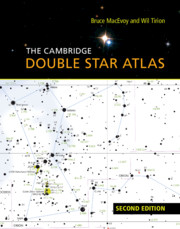Introduction
Published online by Cambridge University Press: 05 May 2016
Summary
This new edition of the Cambridge Double Star Atlas is designed to improve its utility for amateur astronomers of all skill levels.
For the first time in a publication of this type, the focus is squarely on double stars as physical systems, so far as these can be identified with existing data. Using the procedures described in Appendix A, the target list of double stars has been increased to 2,500 systems by adding 1,100 “high probability” physical double and multiple stars and deleting more than 850 systems beyond the reach of amateur telescopes or lacking any evidence of a physical connection. Wil Tirion has completely relabeled the Atlas charts to reflect these changes, and left in place the previous edition's double star icons as a basis for comparison. This new edition provides a selection based on evidence rather than traditional opinion, so that the twenty-first century astronomer can explore with fresh eyes the astonishing actual variety in double stars.
Continuing the emphasis on physical systems, this Atlas explains the origin and dynamic properties of double stars and the role they have played in our understanding of star formation and stellar evolution. The elements of binary orbits, stellar spectral types, and methods of detecting and cataloging double stars, are explained to enrich the observer's understanding of double star astronomy. There is also practical guidance for the visual astronomer – information on optics, equipment preparation, useful accessories, viewing techniques and opportunities for amateur research. The references suggest both print and online double star resources. Finally, over 330 systems in the target list are marked with a star (★) in the left margin. These indicate “showpiece” systems of intrinsic beauty or charm, “challenge” pairs of close separation or large brightness contrast, and several systems that have been important in the history of astronomy. From most observing locations, at least three dozen of these targets will be in view at any time of night on any evening of the year.
Jim Mullaney's choice of nineteenth century double star catalog labels has been retained as a tribute both to his original Atlas concept and to the bygone astral explorers who discovered over 90% of the systems in the target list (see Appendix D).
- Type
- Chapter
- Information
- The Cambridge Double Star Atlas , pp. 1 - 20Publisher: Cambridge University PressPrint publication year: 2015

